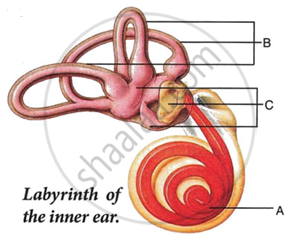Advertisements
Advertisements
Question
The diagram alongside represents the structure of the human ear.
(i) Write the names of the parts labelled a to g.
(ii) State briefly the functions of the parts b, d, and g.
(iii) Name the main division of the ear.
(iv) Which is the smallest bone in the human body?
(v) What is labyrinth?

Solution
(i) (a) Bone of skull
(b) Inner ear
(c) Eardrum
(d) Bone of skull
(e) Bone of middle ear
(f) Middle ear
(g) Air filled
(ii) (b) Inner ear - It transmits the impulse to brain.
(d) Bone of skull - It helps in fixing the position of the ears to help the brain use auditory cues to judge direction and distance of sounds.
(g) Air filled - It keeps the pressure in the middle ear equalized with pressure in the outside.
(iii) The main division of the ear are: outer ear, middle ear and inner ear.
(iv) Stirrup
(v) The labyrinth is the inner ear which consists of utriculus, sacculus, cochlea and three semicircular canals.
APPEARS IN
RELATED QUESTIONS
Which part of our body helps us in maintaining the body balance?
Photoreceptor cells are present in __________.
(A) blind spot
(B) retina
(C) cochlea
(D) cornea
State the main function of the Eustachian tube
What is the function of ear ossicles?
The exact location of the Yellow spot
Give scientific reasons: We cannot distinguish colours in moonlight.
Perilymph or endolymph (Which one surrounds the organ of Corti ?)
Differentiate between members of the following pair with reference to what is asked in bracket.
Dynamic balance and static balance (Definition)
Mention if the following statement is true (T) or false (F) Give reason.
Malleus incus and stapes are collectively called the ear ossicles.
Where is the Cochlea located? Briefly mention its function.
With reference to the human ear, answer the question that follow:
Name the part of the ear associated with
(1) static balance
(2) hearing
(3) dynamic balance.
Name that part of ear which vibrates when outside sound falls on it.
What is the name of passage in outer ear which carries sound waves to the ear-drum ?
The following diagram refers to the ear of a mammal.

(i) Label the parts 1 to 10 to which the guidelines point.
(ii) Which structure:
(a) converts sound waves into mechanical vibrations?
(b) Converts vibrations into nerve impulses?
(c) Responds to change in position?
(d) Transmits impulses to the brain?
(e) Equalizes atmospheric pressure and pressure in the ear.
Given below is the diagram of the human ear. Study the same and answer the questions that follow:

(i) Give the biological term for the part labeled ‘A’ and state its function.
(ii) Name the part labeled ‘B’ and state its function.
(iii) Name the part labeled ‘C’ and state its function.
(iv) Give the function of ear wax.
The range of audible frequency for the human ear is
List the causes of noise pollution.
Choose the odd one out from the following terms and name the category to which the others belong:
Given below is the diagram of a part of the human ear. Study the same and answer the questions that follow:
 |
- Give the collective biological term for Malleus, locus and Stapes.
- Name the parts labelled A, B and C in the diagram.
- State the functions of the parts labelled 'A' and 'B'.
- Name the audio receptor region present in the part labelled 'A'.
